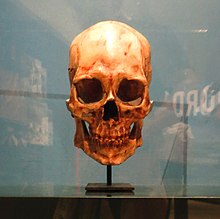 Skull of Kennewick Man. Resin cast by James Chatters | |
| Common name | Kennewick Man |
|---|---|
| Species | Homo sapiens |
| Age | 8,400 to 8,690 years Before Present |
| Place discovered | Columbia Park in Kennewick, Washington |
| Date discovered | July 28, 1996 |
| Discovered by | Will Thomas and David Deacy |
Kennewick Man or Ancient One[nb 1] was a Native American man who lived during the early Holocene, whose skeletal remains were found washed out on a bank of the Columbia River in Kennewick, Washington, on July 28, 1996. Radiocarbon tests show the man lived about 8,400 to 8,690 years Before Present, making his skeleton one of the most complete ever found this old in the Americas,[1] and thus of high scientific interest for understanding the peopling of the Americas.[2][3][nb 2]
The discovery precipitated a nearly twenty-year-long dispute. Native American tribes asserted legal rights to rebury the man under the federal Native American Graves Protection and Repatriation Act (NAGPRA), a law that protects Indian remains from disrespectful treatment, such as storage in labs, museums, and private collections.[5] The United States Army Corps of Engineers, which holds jurisdiction over the land where the remains were found, retained legal custody. The science community wished to conduct research on the skeleton and asserted he was only distantly related to today's Native Americans and more closely resembled Polynesian or Southeast Asian peoples, a finding that would exempt the case from NAGPRA.
Technology for analyzing ancient DNA had been improving since 1996, and in June 2015, scientists at the University of Copenhagen published a study of Kennewick Man's sequenced genome, which found that Kennewick Man is nested within the diversity of contemporary Native Americans, though he cannot be associated specifically with any particular modern group.[1] In September 2016, the US House and Senate passed legislation to return the remains to a coalition of Columbia basin tribes. Kennewick Man was buried according to Indian traditions on February 18, 2017, with 200 members of five Columbia basin tribes in attendance, at an undisclosed location in the area.[6] Within the scientific community since the 1990s, arguments for a non-Indian ancient history of the Americas, including by ancient peoples from Europe, have been losing ground in the face of ancient DNA analysis.[7] The identification of Kennewick Man as closely related to modern Native Americans symbolically marked the "end of a [supposed] non-Indian ancient North America".[7]
Cite error: There are <ref group=nb> tags on this page, but the references will not show without a {{reflist|group=nb}} template (see the help page).
- ^ a b Rasmussen, Morten; Sikora, Martin; et al. (June 18, 2015). "The Ancestry and Affiliations of Kennewick Man". Nature. 523 (7561): 455–458. Bibcode:2015Natur.523..455R. doi:10.1038/nature14625. PMC 4878456. PMID 26087396.et al. list
- Morten Rasmussen
- Martin Sikora
- Anders Albrechtsen
- Thorfinn Sand Korneliussen
- J. Víctor Moreno-Mayar
- G. David Poznik
- Christoph P. E. Zollikofer
- Marcia Ponce de León
- Morten E. Allentoft
- Ida Moltke
- Hákon Jónsson
- Cristina Valdiosera
- Ripan S. Malhi
- Ludovic Orlando
- Carlos D. Bustamante
- Thomas W. Stafford, Jr.
- David J. Meltzer
- Rasmus Nielsen
- Eske Willerslev1
- ^ Preston (2014).
- ^ Stafford (2014).
- ^ Lemonick & Dorfman (2006).
- ^ Gulliford, Andrew (February 28, 2010). "Bones of Contention: The Repatriation of Native American Human Remains". The Public Historian. 18 (4). University of California Press. Archived from the original on December 24, 2023. Retrieved December 24, 2023.
The Smithsonian Institution alone had 18,600 American Indian remains. Indians are further dehumanized by being exhibited alongside mastodons and dinosaurs and other extinct creatures. No other issue has touched a more sensitive chord than these disrespectful nineteenth-century collecting practices.
- ^ "Tribes lay remains of Kennewick Man to rest". The Spokesman-Review. Spokane, Washington. February 20, 2017. Retrieved February 20, 2017.
- ^ a b Cite error: The named reference
Kakaliqouraswas invoked but never defined (see the help page).